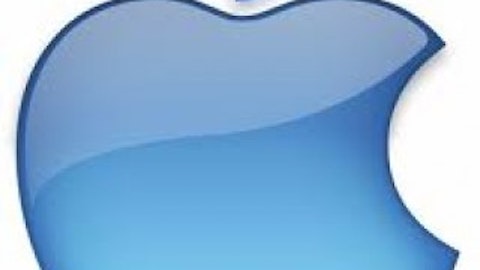Wall Street expects Apple Inc. (NASDAQ:AAPL) to sell around 45 million iPhones this quarter, with some firms holding higher estimates. It’s noteworthy that in the first quarter of FY2012, the Cupertino-based tech giant sold 37 million smartphones, and one year earlier, this total amounted to just over 16 million units. In other words, iPhone sales growth is slowing, but is still expected to be in the 20% range (yoy) next quarter.
Why is this important? Well, for starters, most analysts estimate that the iPhone generates close to two-thirds of Apple’s total profits, and nearly half of its total revenue (via Business Insider). Due to the inherently higher gross margins that smartphones provide in comparison to, let’s say, tablets, we can see why investors should place so much importance on quantifying the iPhone’s success.
Regarding Apple’s newest iteration of the device, there have been multiple reports that even though the company’s smartphone revenue base is increasing, the overall portion that is derived from the iPhone 5 is shrinking. AllThingsD originally reported this phenomenon earlier this month, and we did an analysis as well. Here’s an excerpt:
“A research report from Consumer Intelligence Research Partners shows that “by some metrics, the iPhone 5 underperformed compared to its predecessor, the iPhone 4S.” More specifically, “the iPhone 5 accounted for 68 percent of total iPhone sales during its first month at market — significantly less than the iPhone 4S, which accounted for 90 percent of all iPhone sales during its first month of retail availability.””
There are two ways to look at this scenario. The first, is quite simple: Apple Inc. (NASDAQ:AAPL) is expanding the scope of its marketplace, and is placing a greater focus on consumers with less discretionary income, i.e. those that would be willing to pay less for a slightly outdated iPhone (the 4 or 4S). With a recent discount program available for the iPhone 5 at Wal-Mart (see: Apple iPhone 5 Selling at a Discount in Wal-Mart Stores), it’s clear that this strategy is being employed to at least some degree.
From a bear’s point of view, however, an increased demand for the older “legacy” iPhones may indicate that fewer consumers are viewing the iPhone 5 as a true upgrade from the iPhone 4S, at least on an aggregate scale.
While it is temping to think that investors shouldn’t care which iPhone model Apple Inc. (NASDAQ:AAPL) sells, as long as the revenue base is growing, it’s crucial to realize that Apple’s best margins come from its newest smartphone. Jefferies expects gross margins from the iPhone 5 to hit 55% in Q1, which is inherently higher than the profit per unit Apple receives from older, discounted phones.
Keeping both of these viewpoints in mind, we can therefore infer that the best trend investors could hope to come from Apple’s iPhone corner is: (1) +20% iPhone revenue growth in Q1, and (2) an improving preference for the iPhone 5, versus the 4 and 4s models.
While the aforementioned CIRP report is intriguing, it doesn’t tell the updated story, as it measured iPhone preferences in the iPhone 5’s first month on the shelves. Nearly two months later, a survey from Morgan Stanley and AlphaWise (via AppleInsider) shows that holiday shoppers actually prefer the iPhone 5 over the iPhone 4S to a greater degree than last year’s shoppers preferred the 4S to the 4. Here’s what AppleInsider had to say about the survey:
“86 percent of respondents planning to buy an iPhone said they would choose the iPhone 5, which starts at $199 with a two-year service contract. In comparison, the same poll a year ago found that 82 percent said they would purchase the iPhone 4S, which at the time was Apple’s latest model sold at that same price […] 10 percent of customers who plan to buy an iPhone said they would choose the iPhone 4S, which sells for $99 with a new two-year service contract […] In the same survey a year ago, 15 percent of customers said they would choose the iPhone 4, which was then sold for $99”
According to Morgan Stanley and AlphaWise, this year, the remaining 4% of participants said they preferred the 2010-era iPhone 4 – a percentage that remained relatively unchanged to one year earlier, when 3% of participants said they’d still want the iPhone 3GS. While we won’t know the absolute totals until Apple Inc. (NASDAQ:AAPL) releases its Q1 results, this survey is very encouraging, as it indicates that our bearish point of view described above may not be coming to fruition.
Due to the fact that such a large portion of Apple’s earnings ultimately come from its iPhone line, investors must be aware that any blowout in the 45-48 million range (total Q1 unit sales) can have an equally positive effect on EPS totals. Next quarter, the Street’s consensus estimate is $13.50 in earnings per share, in a 13-week period that is seven days shorter than Apple’s fiscal Q1 in 2012.
Because of this discrepancy, the $13.50 figure is actually below Apple’s EPS one year earlier ($13.87), but when we adjust for this extra week, we can actually see that earnings are expected to grow by 4-5% year over year. Another way to perform this adjustment is by breaking Apple’s Q1 earnings into weekly totals; in Q1 FY2012, Apple made an average of 99 cents per week over a 14-week timeframe. In Q1 FY2013, Apple Inc. (NASDAQ:AAPL) is expected to make an average of $1.04 per week over a 13-week timeframe.
Over the longer term, sell-side analysts expect Apple to average EPS growth of 19-20% a year over the next half-decade, with next year likely to bring an iPhone 5S, possibly in new color options according to Jefferies analyst Peter Misek. It’s notable that these estimates outpace what’s expected of Google Inc (NASDAQ:GOOG) (15.7%), Microsoft Corporation (NASDAQ:MSFT) (9.6%), International Business Machines Corp. (NYSE:IBM) (9.9%), and Hewlett-Packard Company (NYSE:HPQ) (2.2%).
Despite the fact that Apple Inc. (NASDAQ:AAPL)’s stock has been down by more than 25% over the past three months, the company still has obvious advantages in the growth department, and the markets are misjudging this potential quite a bit. Using the price-to-earnings growth ratio, which can tell us just how investors are valuing a company’s forward EPS estimates, we can see that AAPL sports a PEG of 0.59. This is far, far below Google (1.4), Microsoft (1.5), and IBM (1.4). With a forward P/E of 8.8X, Apple’s earnings stream is being valued close to on par with that of Microsoft (8.3X), despite the fact that Apple’s EPS growth is expected to be twice as high.
We could continue to slice and dice the numbers, but the message is clear: when compared to its competitors, Apple Inc. (NASDAQ:AAPL) can still be considered a growth investment, and this potential can be had at a very reasonable price at the moment. The iPhone, which is responsible for the majority of Apple’s earnings, is still performing well, and aggregate sales totals are expected to be up considerably by the end of the quarter. As mentioned in the survey above, early worries that older “legacy” models were cutting into the iPhone 5’s sales seem to have subsided, as holiday shoppers actually look to prefer the smartphone to a greater degree than they preferred the iPhone 4S last year.
With a projected dividend yield above 2%, income-oriented investors can also consider Apple Inc. (NASDAQ:AAPL) to be a solid addition to their portfolios, with considerable upside once near term profit-taking subsides at the turn of the calendar year.





